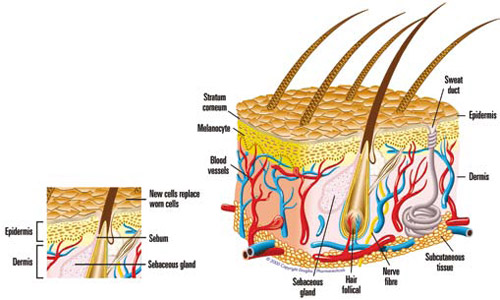What is Acne?
Acne is a common skin condition. Acne consists of blackheads, whiteheads, red spots, and sometimes deeper boil-like spots, these are called nodules or cysts. Acne affects most people during their teenage years. However, the problem sometimes continues into adulthood.
Acne develops in the oil-producing glands of the skin. These glands are called sebaceous glands. The oily substances produced by the sebaceous glands is called sebum. The sebaceous glands are present in large numbers on the face, chest, upper back and shoulders. The seba-ceous glands are connected to the hairs that grow in the pores in these areas.
Normally, sebum flows on to the surface of the skin through the pores. As the sebum flows through the pore it gets rid of dead skin cells from the lining of the pores.
Acne occurs when an excess of sebum is made. The excess sebum mixes with the dead skin cells from the lining of the pore and forms a “plug”. This plug blocks the pore. None of the sebum and dead skin cells that are still being produced can escape from the pore. This builds up and results in a pimple.

What Causes Acne?
The exact cause of acne is unknown. Acne is not caused by dirty skin and acne is not a problem suffered only by teenagers.
There is no medical evidence that food causes acne, not even eating chocolate or drinking cola. Following a diet will not clear your acne by itself. On the other hand, some people find that their acne seems to get worse when they eat certain foods like chocolates, fried food and chillies. If you find that this is the case you should avoid the foods that appear to make your acne worse.
One idea about the cause of acne is that as the changes due to puberty occur the skin of an acne prone person reacts to these changes by making excess sebum. This extra sebum causes a plug to form, blocking the pore and resulting in the development of a pimple. When this occurs in several places at the same time, the result is acne. Emotional stress, fatigue and cosmetics can make acne worse.
Acne most commonly first appears at the beginning of puberty when the production of hormones (called androgens) is increased. The sebaceous glands also become more active at this time. Many people outgrow acne when they reach adulthood, as the sebaceous glands settle in to a normal cycle. Some people never outgrow acne and they may be bothered by it their whole lives.
Sometimes women tend to break out in a pattern that follows the course of their menstrual cycle.
Family history is a factor in determining if you will get acne. If one or both of your parents had acne chances are that you may also get acne.
Outside factors can affect acne, either causing acne or make existing acne worse. Grease and oils or the use of some cosmetics and hair products can cause or irritate acne. Besides being irritants these products can act like sebum and block pores.
If you find that you break out with acne around the hairline, at the temples and in front of your ears, your hair products may be to blame. For instance, the shampoo you use, or the hair gel you use or your hairspray may be blocking your pores. Another area that can be affected by outside factors is the jaw line. Break outs in this area can be the result of resting your head in your hand or even resting the telephone on your shoulder for long periods of time.
Although acne is not caused by dirt, it is helpful to keep the face clean. Gentle cleansing twice daily can help by cutting down on the amount of common bacteria on the skin, and by reducing the amount of other materials on the skin that can also act like sebum and contribute to the blocking of the pores. This cleansing can be accomplished by washing the face twice daily with warm (not hot) water and a mild antibacterial soap. Your fingers are actually the best washcloth you can use. If you do use a facecloth, be gentle. Scrubbing irritates pimples already present and can increase inflammation, it can also contribute to the formation of cysts.